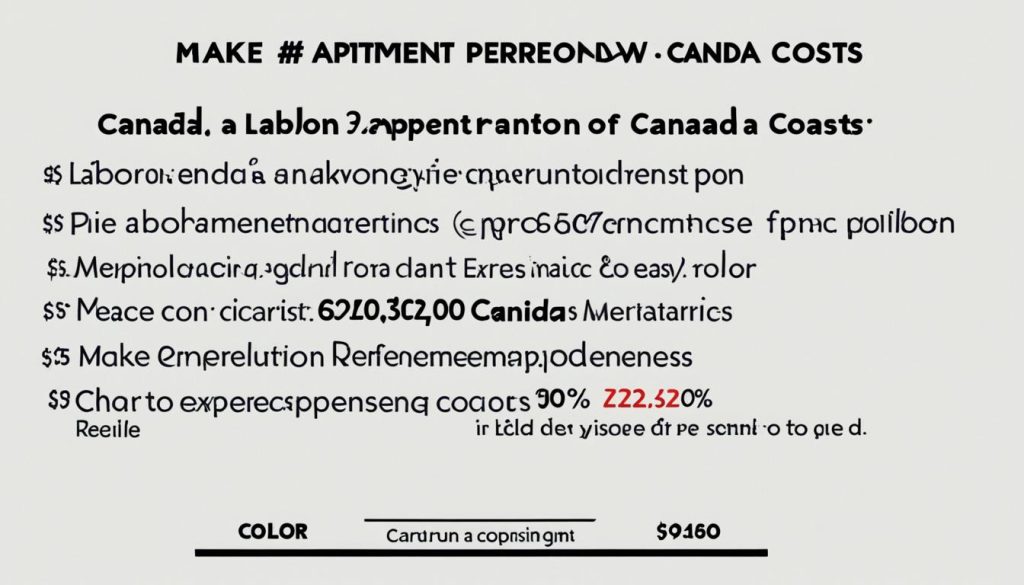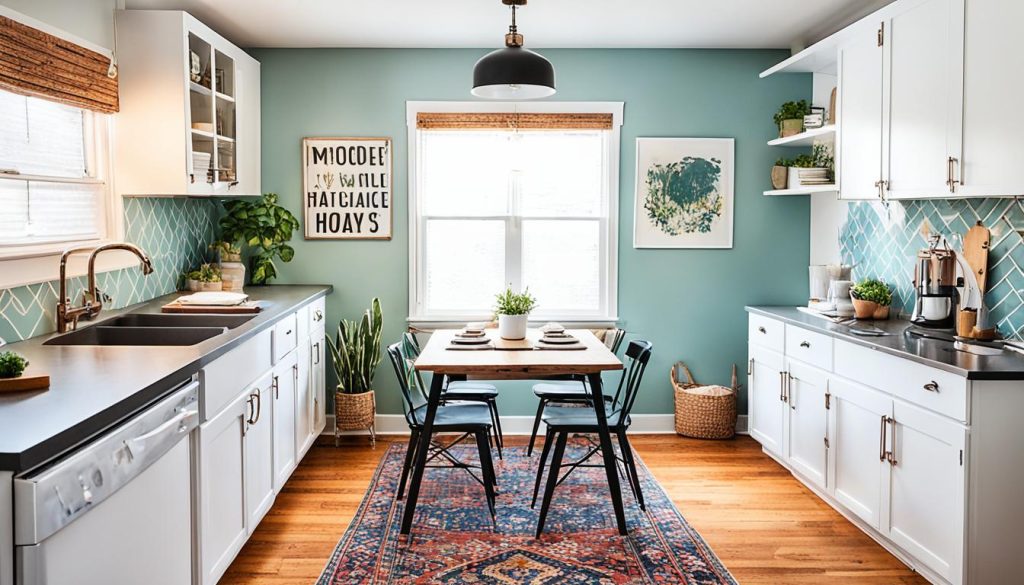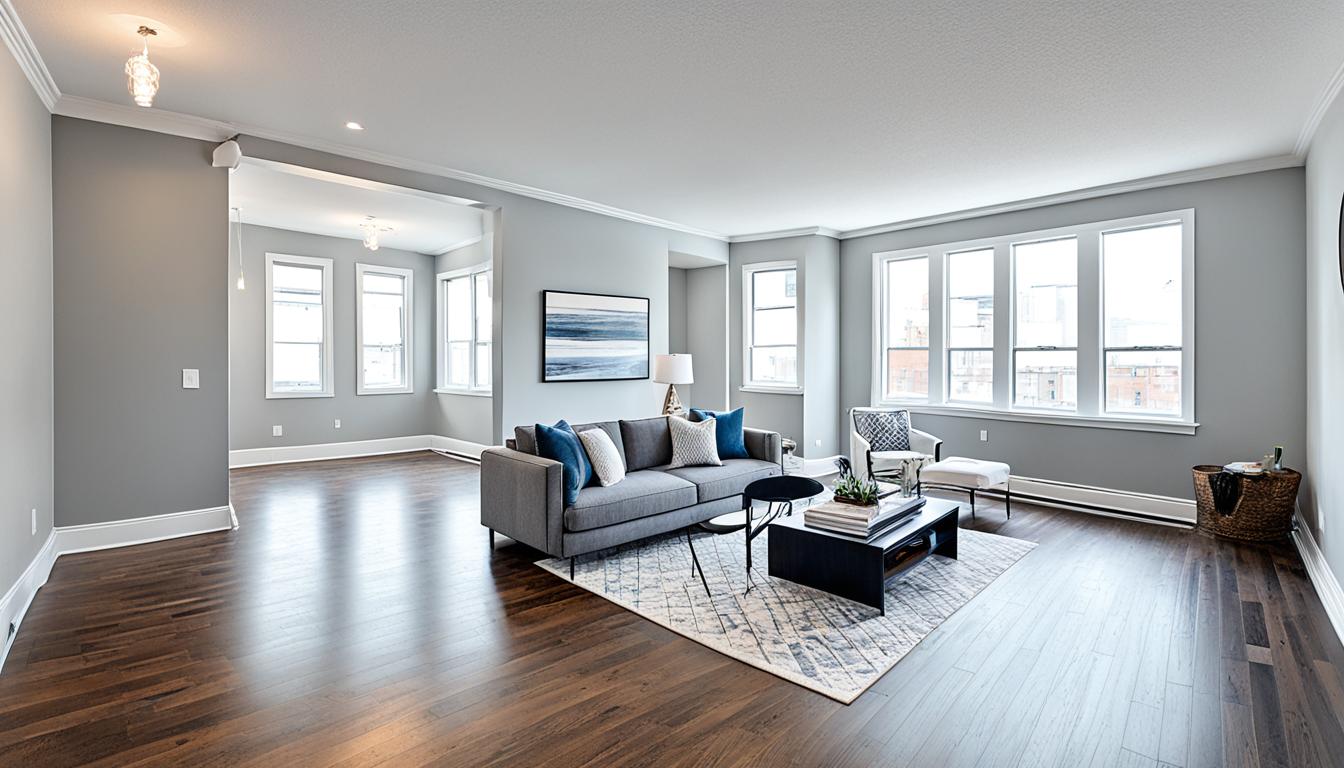Did you know that landlords in Ontario have spent hundreds of millions of dollars renovating aging apartment buildings since 1998? That’s right! The province switched to a vacancy decontrol system, prompting landlords to invest in upgrading their properties. These renovations have completely transformed older buildings into essentially new ones, with upgrades such as parquet flooring, new bathrooms, and renovated kitchens.
But what does it actually cost to renovate an apartment in Canada? How do landlords budget for these renovations and determine the return on their investment? In this article, I’ll uncover the average costs of apartment renovations, factors that can influence these costs, budgeting tips for affordable renovations, financing options, and even tax benefits and incentives for apartment remodels.
Key Takeaways:
- Apartment renovations in Ontario have cost landlords hundreds of millions of dollars since 1998.
- The average cost of a standard apartment renovation is approximately $10,000 per unit.
- Factors such as the size of the unit, extent of renovations, and location can influence renovation costs.
- Affordable apartment renovations can be achieved through strategic planning, prioritizing impactful changes, and exploring cost-effective options.
- Financing options for apartment renovations include personal savings, loans, and government programs.
Factors Influencing Apartment Renovation Costs
When it comes to renovating an apartment, there are several factors that can greatly influence the overall cost. Understanding these factors is important to create a realistic budget and ensure a successful renovation project. Here are key considerations for apartment renovation budgeting:
- Size of the unit: The size of the apartment will directly impact the cost of renovations. Larger units will require more materials and labor, resulting in higher expenses.
- Extent of the renovations: The scope of the renovation project will also play a significant role in determining the cost. Minor updates, such as repainting and replacing fixtures, will be less expensive compared to a full-scale remodel involving structural changes.
- Quality of materials used: The choice of materials will influence both the cost and the overall outcome of the renovation. Investing in high-quality materials may incur a higher initial expense but can lead to long-term durability and aesthetic appeal.
- Location of the apartment: The geographical location of the apartment can impact renovation costs due to variations in labor and material prices. Renovations in urban areas or regions with high demand may be more expensive compared to more affordable locations.
- Cost of hiring contractors and professionals: If you decide to hire professionals for your apartment renovation project, the cost of their services will be an important consideration. It’s advisable to obtain multiple quotes and evaluate the expertise and reputation of contractors before making a final decision.
- Permits and approvals: Depending on the complexity of the renovations, you may need to obtain permits and approvals from local authorities. These additional costs should be factored into your budget.
- Unforeseen issues: It’s essential to account for unexpected challenges that may arise during the renovation process. Setting aside a contingency budget will help cover any unforeseen expenses or changes that need to be made.
By carefully considering these factors and making informed decisions, you can effectively plan your apartment renovation project while staying within your budget. Remember, thorough preparation and research are key to a successful and cost-effective renovation.
Apartment Renovation Cost Breakdown
When planning an apartment renovation, it’s crucial to understand the cost breakdown to have a realistic budget. The specific expenses may vary depending on the project, but here are the main components to consider:
- Materials: These include items such as flooring, cabinets, fixtures, and appliances. The cost of materials can vary greatly depending on the quality and brand chosen.
- Labor: Hiring professionals is often necessary for tasks like carpentry, plumbing, electrical work, and general contracting. The total labor cost will depend on the complexity and duration of the renovation.
- Additional Services or Fees: Apart from material and labor expenses, there may be additional costs such as permits, design fees, and project management fees. These fees ensure that the renovation proceeds smoothly and according to legal requirements.
By breaking down the overall cost into these categories, you can estimate the expenses involved in your apartment remodel accurately.

| Category | Percentage of Total Cost |
|---|---|
| Materials | 40% |
| Labor | 50% |
| Additional Services or Fees | 10% |
The table above provides a sample breakdown of how costs may be allocated. However, keep in mind that the percentages can vary depending on the nature of your renovation project.
Tips for Affordable Apartment Renovations
Renovating an apartment doesn’t have to break the bank. With some careful planning and smart choices, you can give your apartment a fresh look without spending a fortune. Here are some budget-friendly tips for affordable apartment renovations:
- Repaint walls: A fresh coat of paint can instantly transform the look and feel of any space. Opt for light, neutral colors to make the apartment appear larger and brighter.
- Focus on key changes: Instead of completely replacing fixtures and hardware, consider giving them a makeover. For example, swap out old cabinet knobs and drawer pulls for new ones to update the overall aesthetic without the cost of replacing the entire unit.
- Shop second-hand: Don’t underestimate the treasures you can find at thrift stores, consignment shops, or online resellers. Look for gently used furniture and decor pieces that can add character to your apartment at a fraction of the cost.
- Prioritize impactful changes: If you’re working with a limited budget, focus on changes that can make a big impact. This could include investing in good lighting fixtures, updating window treatments, or adding a stylish area rug to tie the room together.
- Consider DIY options: Tackling small renovation projects yourself can save you a significant amount of money. Simple tasks like replacing light fixtures, installing new flooring, or adding a backsplash can be done with a little research and patience.
- Research cost-effective materials: Explore different materials and finishes that offer both quality and affordability. For example, laminate flooring can mimic the look of hardwood at a fraction of the cost.
By implementing these tips, you can create a beautiful and inviting space without overspending. Remember, it’s all about being strategic with your choices and finding creative solutions to achieve your desired look.

Estimated Costs for Common Apartment Renovation Projects
| Renovation Project | Estimated Cost |
|---|---|
| Painting (per room) | $200 – $500 |
| Hardware and fixture replacements | $50 – $200 (per item) |
| Thrifting and second-hand furniture | $100 – $500 (per piece) |
| Lighting fixtures | $100 – $300 (per fixture) |
| DIY flooring installation | $1 – $5 per square foot |
| Cost-effective materials | Varies depending on the type of material |
Financing Options for Apartment Renovations
When it comes to financing apartment renovations, there are several options available. As a landlord, I understand the importance of finding the right funding sources to support my apartment remodels. Whether you’re planning minor upgrades or a major transformation, considering the right financing options can make all the difference in your project’s success.
Self-Funding or Taking out a Loan
One financing option is to fund the renovations yourself. This can be done using personal savings or by taking out a loan specifically for apartment renovations. Self-funding gives you full control over your project and allows you to avoid potential interest charges. However, it’s essential to assess your financial situation and consider the impact on your cash flow.
If self-funding isn’t feasible, applying for a loan is a practical solution. Many financial institutions offer loans specifically tailored for apartment renovations. These loans usually have competitive interest rates and flexible repayment terms. Before applying, it’s essential to research and compare different loan options for apartment renovations to secure the best terms that align with your financial goals.
Government Programs and Grants
Another avenue to explore is government programs and grants available for apartment remodels. One such program is the Canada Greener Homes Initiative, which provides grants and loans for home evaluations and retrofits. This initiative aims to promote energy-efficient upgrades, and apartment renovations may be eligible for financial support. Researching and understanding the requirements and application processes of these programs can potentially provide additional funding for your project.
Additionally, there may be other provincial or regional government programs that offer financial incentives, tax credits, or rebates for certain renovation projects. These programs can significantly reduce the overall cost of apartment renovations while encouraging sustainable and eco-friendly improvements. It’s crucial to consult local resources and government websites to explore all available options.
| Funding Source | Description |
|---|---|
| Self-Funding | Using personal savings or funds to finance apartment renovations |
| Loans | Borrowing money specifically for apartment renovations, offering competitive interest rates and flexible repayment terms |
| Government Programs and Grants | Exploring initiatives like the Canada Greener Homes Initiative and other regional programs that provide financial support for apartment remodels |
Considering the financing options available for apartment renovations is a crucial step in planning and executing your project. Determining your budget, evaluating the costs, and exploring different funding sources will help you make informed decisions and maximize the potential return on your investment. Remember to thoroughly research each option and consult with financial advisors or experts if needed.
Increasing Property Value through Apartment Renovations
Renovating an apartment can have significant benefits beyond just improving its functionality and aesthetics. One of the key advantages is the potential to increase the property’s market value, providing landlords with a higher return on investment.
By investing in upgrades and improvements, landlords can enhance the marketability of their apartments and attract higher-paying tenants. This can result in increased rental rates, ultimately maximizing the return on investment for the apartment remodel.
There are several strategies that landlords can employ to increase the property value through apartment renovations:
- Upgrading common areas: Improving shared spaces such as lobbies, hallways, and recreational areas can enhance the overall appeal of the apartment building. Adding modern design elements, comfortable seating areas, and attractive lighting can create a welcoming atmosphere for residents and potential tenants.
- Improving curb appeal: First impressions are crucial in the real estate market. Enhancing the exterior of the apartment building with fresh paint, landscaping, and well-maintained entrances can significantly impact its marketability. A visually appealing exterior can attract potential tenants and increase the perceived value of the property.
- Enhancing energy efficiency: In today’s environmentally conscious world, energy-efficient features can be a major selling point. Installing energy-efficient appliances, windows, and insulation not only reduces utility costs for tenants but also adds value to the property. Energy-efficient upgrades can contribute to the overall appeal and marketability of the apartment.
By carefully considering these strategies and implementing them effectively, landlords can transform their apartments into highly desirable living spaces, attracting quality tenants and increasing the property’s value.
Image: Renovated apartment showcasing modern design and upgraded features.
Tax Benefits and Incentives for Apartment Renovations
When it comes to apartment renovations in Canada, there are enticing tax benefits and incentives available for landlords. These incentives can help offset the costs of renovations and make them more financially viable. One such program is the Canada Greener Homes Initiative, which provides grants and loans for eligible retrofits. This program supports initiatives such as home insulation, heating upgrades, and renewable energy installations, all aimed at making apartments more energy-efficient.
In addition to the Canada Greener Homes Initiative, landlords may also find provincial tax credits and rebates for specific renovations and energy-efficient upgrades. These credits and rebates can further reduce the renovation costs and provide long-term financial savings. It’s important for landlords to consult with tax professionals to understand the available benefits and determine which renovations qualify for tax credits.
By taking advantage of these tax benefits and incentives, landlords can make their apartment renovations more affordable and sustainable. Not only do these incentives help reduce the upfront costs of renovations, but they also contribute to a more environmentally friendly approach to property management. This can be appealing to tenants who value sustainability and energy efficiency, giving landlords a competitive edge in the rental market.

Leave a Reply
You must be logged in to post a comment.